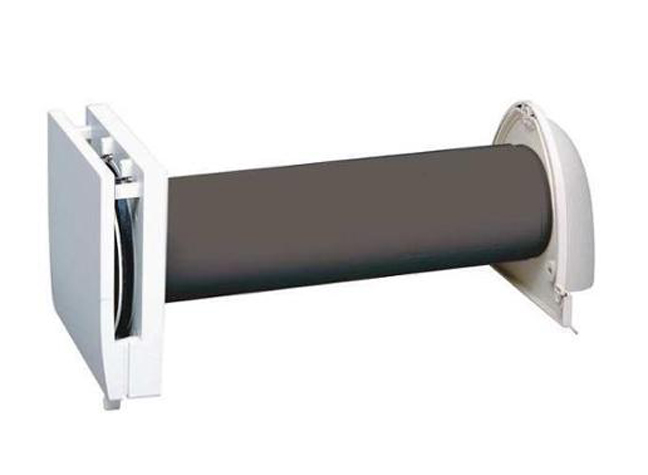
Image Credit: Image #1: Panasonic
If your house has an exhaust-only ventilation system, does it need passive air inlets — that is, holes in the wall to let in outdoor air? In most cases, the answer is no. Unless your house is very, very tight — close to the Passivhaus standard of 0.6 ach50 — your building’s envelope is almost certainly leaky enough to allow for the smooth operation of a bathroom exhaust fan rated at 50 cfm or 100 cfm.
What’s wrong with passive air inlets? As I wrote in my 2009 article, Designing a Good Ventilation System, these aren’t “smart holes.” They’re just holes — and they’re just as likely to let air escape from a house as they are to let air in. The forces determining whether air enters or leaves these passive air inlets (also known as trickle vents) are the stack effect and wind, not the operation of a bathroom exhaust fan.
These facts were recently confirmed by Sean Maxwell in an article called “Ventilation: The Only Way That Passive Vents Will Work” (Home Energy magazine, January / February 2016). Maxwell formerly worked as a senior energy consultant at Steven Winter Associates in Norwalk, Connecticut; he now lives in Australia.
In his article, Maxwell describes the results of a research project he was involved with that looked into the efficacy of passive air inlets in multifamily apartment buildings in the U.S. Maxwell is one of three authors of the report, “Evaluation of Ventilation Strategies in New Construction Multifamily Buildings,” describing the research project. (His co-authors were David Berger and Marc Zuluaga.) The research was funded by the National Renewable Energy Laboratory as part of the Building America program.
While the researchers focused on apartments in multifamily buildings, many of their conclusions are applicable to single-family homes.
In a nutshell, they found that passive air…
Weekly Newsletter
Get building science and energy efficiency advice, plus special offers, in your inbox.

This article is only available to GBA Prime Members
Sign up for a free trial and get instant access to this article as well as GBA’s complete library of premium articles and construction details.
Start Free TrialAlready a member? Log in





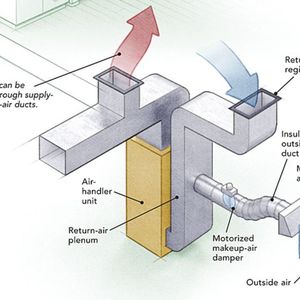
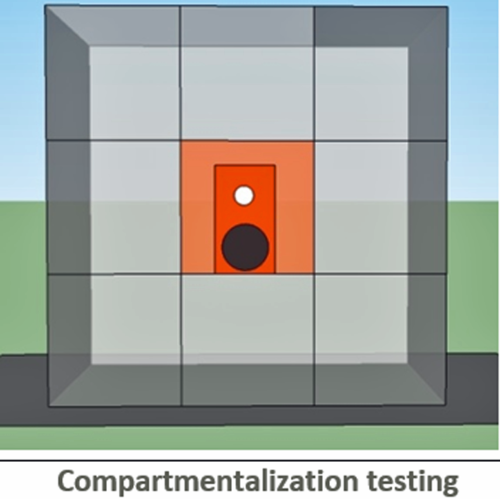
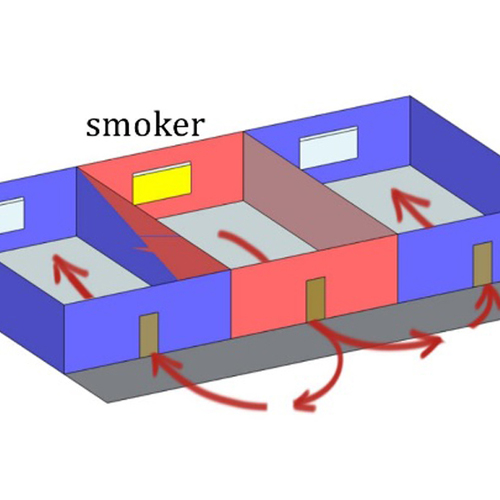
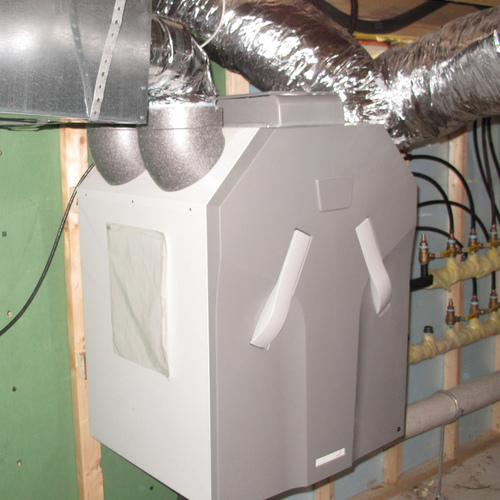






18 Comments
Converting ach50 to cfm50
You say that, in the example building, 3 ach50 translates to 0.25 cfm50, but 0.6 ach50 would still not meet the 0.1 cfm50 target. If they are proportional, then 0.6 ach50 should be 0.05 cfm50 which is less than 0.1 cfm50.
Response to Reid Baldwin
Reid,
You haven't reported the units accurately.
I wasn't talking about cfm50; I was talking about cfm50 per square foot of envelope. You guessed correctly: there is no formula for converting ach50 to cfm50 per square foot of envelope, because these units are not proportional. That's why I wrote, "It’s impossible to convert Maxwell’s target — 0.1 cfm50 per square foot of envelope — to air changes per hour at 50 Pascals of pressure difference (ach50), because the conversion factor depends on the shape of the building under discussion."
If a house has a convoluted shape, with lots of ells and bays and bump-outs, the area of its envelope will be high. If a house has a compact shape -- the classic "stacked shoe-boxes" shape -- the area of its envelope will be low.
A blower door test measures cfm at 50 pascals of depressurization. If this number is X, then a house with a convoluted envelope will have a lower value for cfm50 per square foot of envelope than a compact house with the same blower-door result (X). In reality, what usually happens is that the compact house has a blower door result of X, while the convoluted house has a blower door result of 3X or 4X.
Response to Martin
For a given building, they should be proportional, although the constant of proportionality will vary from one building to another.
Response to Reid Baldwin
Reid,
If a weatherization crew is performing air sealing work on an existing building, using a blower door to find air leaks and sealing the leaks as they go, you're right. If they compare two cfm50 readings on their blower door -- one reading taken before air sealing work was performed, and another reading taken after air sealing work was performed -- then the ratio between ach50 and cfm50 per square foot of envelope would be the same for the two blower-door tests.
The ratio is the same (in this case) because both blower door readings were taken at the same building.
Response to Martin
I think we agree that the ratio should be constant for this building. My point was that your conclusion that the building in question would not meet the target is not consistent with the numbers you quote.
If 3 ACH50 translates to 0.25 cfm50 / ft^2 for this building, then 0.6 ACH50 translates to 0.05 cfm50 / ft^2 for this building. Since 0.05 < 0.1, this meets the target.
Response to Reid Baldwin
Reid,
Thanks for pointing out my error; I realize now that Allison Bailes was talking about two different houses. The confusion is mine. I will correct the text.
Thanks for your sharp eyes.
I recently completed construction of a 700 sqft ADU that had a blowerdoor score of 1.37 ACH 50. I have a 80cfm Panasonic fan being controlled by a scheduled switch. I have one Panasonic passive air inlet installed. House has been occupied for a few weeks( all p-traps are wet). When fan is running there seems to be a sewer smell coming from washer supply/ drain box. When bathroom fan is running, I can feel air movement through the passive air inlet. Based on the article it doesn't seem like the ADU is tight enough to be pulling sewer gas from the P/traps, but I can't explain the link between the fan operation and smell? I was considering adding another passive air inlet, or a point source HRV, but I am not skeptical this would work after reading this article. Any help or advice would be greatly appreciated!
Thanks,
Jesse
Jesse,
If a P-trap is wet, there is no way that an 80 cfm bathroom exhaust fan will pull water out of the trap. So that's not the issue.
Have you checked the p-trap on the laundry drain? If venting is compromised elsewhere in the house, the laundry p-trap could be emptying itself.
Air comes in and maybe out
We have a passive vent I was required to put in to get approval for our wood stove. I can feel air entering the house when the stove is on and when the kitchen exhaust is running. Sometimes I can feel air entering when neither of those are happening. Probably the same is true of air leaving the house. I guess that isn't surprising given your blog.
Response to Andrew Bater
Andrew,
The gravity damper you installed is similar to some passive air inlet designs. It will certainly open when your house is adequately depressurized by your exhaust appliances. The problem (as you imply) is that it will also open up in certain wind conditions.
"Smart" Passive Venting Experimentation
I am experimenting with a "smart" passive vent in our extremely tight home.
First pass is a cheap ($15.00 - eBay!) 4" flue damper turned around in the wall. It opens when the clothes dryer and range hood run, when the HRV goes into defrost, and when I run our masonry heater. I took some pictures with my cellphone camera that show the degree it opens when the 1st floor clothes dryer runs, and that it opens even further when I shut the HRV off, thus illustrating that the HRV is typically slightly pressurizing the house. (Apologies my two pix aren't exactly the same perspective.)
This system works for us as this vent is on the leeward side of the house and somewhat sheltered.
Rev 3 of this venting is in the works, just bought a slightly more elegant Honeywell static pressure balancing damper off eBay - $45! (Rev 1 was a backwards spring loaded damper, one that was rejected for our kitchen range hood as the spring was pretty lame.)
Modulate the HRV?
Martin, I am interested in commercially available solutions or discussions of other home brew fixes. Please forward on if you see any that appear to have promise.
I think the ideal solution would be some sort of indoor/outdoor static pressure sensor/control system that would modulate the fan in my HRV. Maybe something along the lines of what hospitals use to manage the environment in infectious care units. For now (and likely TFN), I will open a window until I get enough draft in my masonry heater to overcome the inertia of the make up air gravity damper!
Response to Andrew Bater
Andrew,
You wrote, "I think the ideal solution would be some sort of indoor/outdoor static pressure sensor/control system that would modulate the fan in my HRV."
Such a control exists. It is expensive. About once a year, a GBA reader like you suggests that it would be good idea if a company made such a control. When they hear that the control is already on the market, and when they hear about the device's price tag, they usually lose interest.
The control you seek is called the Exhausto EBC 14. Here is a relevant link:
EBC 14 Pressure Control
I wrote an article about the device for the January 2008 issue of Energy Design Update. In that article, I wrote, "The EBC 14 consists of three components: a control box, an indoor pressure sensor, and an outdoor pressure sensor. The control box includes an LCD display showing the indoor room pressure. The control compares the indoor air pressure to the outdoor air pressure; if the indoor space becomes depressurized, the control energizes a variable-speed supply fan. The control modulates the fan speed in order to supply just enough fresh air to the house to correct the depressurization. (The EBC 14 can control a single-phase fan directly, or a three-phase fan indirectly, by means of a variable frequency drive.)
"The outdoor sensor is sold separately. It must be installed on a roof or exterior wall, and connected to the indoor control with a 50-foot length of silicone tubing. The installation instructions advise, ‘Select a mounting location as free as possible from rooftop obstructions. … Install the probe on an existing structure, like a pole, radio or TV antenna mast. Alternately, the L-shaped bracket can be attached directly to any wall or rooftop. … Obstructions such as trees, chimneys, signs, and buildings all cause turbulence, which results in abnormal and thus inaccurate static pressure. Position the probe as far from the sources of turbulence as possible.’
"The main disadvantage of the EBC is its high price; it lists for $1,500, although contractors will pay significantly less. Moreover, a complete makeup air system will require several other components in addition to the EBC 14 control: the outdoor sensor, a supply air fan, and, in some cases, a heating coil to condition the makeup air."
Exhausto - HRV Balancing versus indoor/outdoor temps
Martin, thanks. I enjoyed reading about the "Exhausto" EBC 14. (Kind of a Veg-O-Matic name isn't it.) Doesn't seem to be much current literature on it, but the links you sent were great.
Even if I did decide to pony up the $1500 it might only be border line sensitive enough to compensate for exhaust fan depressurization in my house. It specs at a tolerance of .01 inWC and worst case, with the gravity damper sealed off, my HRV balance appears to shift about .025 when I run the range fan, the dryer about .01 or so. (I have a manometer across the HRV.) Enough to nicely open the gravity damper though.
What would be interesting, and you probably know someone who has already examined this, is that there is definitely a shifting of the HRV balance depending on indoor and outdoor temperature variations. Enough to make it worthwhile to spend money to fix that problem? Probably not, especially since one of your other links took me to a discussion about whether even a dumb HRV is worth it from an energy recovery perspective!
Maybe next winter maybe I will rig up some instrumentation to record temp versus pressure data. (Only 54 days to the first day of spring!)
Andrew Bater's concern about HRV Balance
In certain situations, HRV balance is overrated. I think we balance fans for 2 reasons. One is to make sure the house in neither depressurized or pressurized. The other is to maximize the thermal efficiency of the HRV or ERV unit. Both good reasons but we can only balance for one set of circumstances which generally means no exhaust fans running and not much wind blowing either. When it comes to the issue of make up air for an exhaust fan I think the focus should be on maximizing heat recovery and controlling where the make up air comes from. As for thermal efficiency, thermal efficiency is a means to an end. The end is recovering heat and the maximization of heat recovery is not exactly the same as the maximization of thermal efficiency in some situations.The primary objective is to recover heat and thermal efficiency is only part of the equation. For example, a perfectly balanced HRV running at low speed with 50 cfm in and 50 cfm out and operating at 80 % efficiency with an inside/outside temperature differential of 40 degrees would capture enough heat from the exhaust air to warm 50 cfm of intake air 32 degrees. Now suppose you activate a 100 cfm bathroom exhaust (vented to the outside) There has to be 100 cfm of make up air coming from somewhere (it may not be instantaneous due to the elasticity of air but it will ultimately reach an equilibrium). In a relatively tight HRV equipped house there should presumably be 100 cfm total coming in through a combination of building envelope leaks, a passive vent if so equipped, and increased flow through the HRV intake (thereby unbalancing the HRV). Let's say the house was really, really tight and didn't have a passive vent and 50 cfm of make up air leaked in and 50 was added to the HRV intake so that now the HRV had 100 cfm in and 50 out. So your HRV efficiency is drastically reduced but so what? Even if efficiency were to drop in half to 40% you would still have recovered the same amount of heat since you are now adding 16 degrees to 100 cfm instead of 32 degrees to 50 cfm. And it won't drop in half because the increased air velocity through the heat exchanger will extract more heat from the 50 cfm of exhaust air. You will recover more heat at a lower efficiency.
With no exhaust fan operating, sure you want the system to be balanced. But when the fan comes on, the only way to re-balance would be to restrict the HRV intake and force more make up air through leaks. Your system may be balanced and you may have maxed out HRV efficiency, but you would be recovering less heat.
And with multi speed fans there are relatively simple ways to improve balance. Any exhaust fan that vents to the exterior could trigger a higher speed for the HRV intake fan only. It's better to have make up air go through the HRV than through leaks. And you can install a powered bathroom fan that vents through the HRV. With the bath fan off and both HRV fans running at low speed, there will be a small amount of continuous ventilation. Turning on the bath fan would signal the HRV supply fan to a higher speed, improving balance. Would the balance be perfect? Not likely, so efficiency would drop but the quantity of recovered heat would increase (compared to just venting the bath fan to the exterior in which case there is virtually no recovery).
Response to Buzz Burger
Buzz,
Thanks for your comments. I agree with some of your analysis -- for example, "HRV balance is overrated" -- but I disagree with some of your suggestions.
You wrote, "And with multi-speed fans there are relatively simple ways to improve balance. Any exhaust fan that vents to the exterior could trigger a higher speed for the HRV intake fan only." In fact, implementing this suggestion is neither "relatively simple" nor recommended. For one thing, it would (as far as I know) violate the HRV manufacturer's instructions, thereby voiding the HRV warranty.
You wrote, "You can install a powered bathroom fan that vents through the HRV." Implementing this suggestion would also (as far as I know) violate the HRV manufacturer's instructions. If you want your HRV to pull exhaust air from a bathroom, all you need to do is to install a ceiling grille and connect that grille to the HRV's exhaust port; there is no need for a bathroom exhaust fan. Here is a link to an article with more information on this issue: Does a Home with an HRV Also Need Bath Fans?
If you decide that your home needs a bathroom exhaust fan in addition to an HRV, the bathroom exhaust fan needs a dedicated duct that is not connected to the HRV.
Make up air through HRV
I don't believe there is an HRV product out there that does this - but it's too bad there isn't an HRV with larger supply to the outside that could handle the total requirements (say 300-500 CFM) for a range hood, clothes dryer, wood stove, etc. The HRV could run as usual most of the time - but when necessary - there could be a separate makeup air fan to bring in air through the HRV as make up air.
Log in or become a member to post a comment.
Sign up Log in